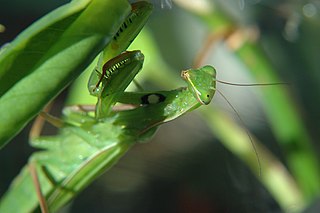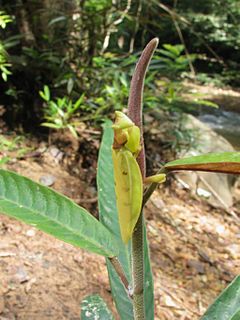
Empusidae is a family of plant-mimicking mantises, consisting of 10 genera, holding almost 30 species. Unlike many other mantis families, the Empusidae are a monophyletic lineage. Empusidae mantises are ambush predators, with mouthparts adapted to feeding on other insects and small animals. The majority of Empusidae species are distributed throughout Africa, but they are also found in Southeast Asia and in the southern parts of Europe.

The mantis family Metallyticidae consists of a single small genus, Metallyticus, living mostly in South-East Asia. The species are dark, somewhat flattened and cockroach-like, often with a cuticle that is reflective and metallic in appearance.

Mantoida is a genus of mantis in the family Mantoididae.

Gongylus gongylodes, also known as the wandering violin mantis, ornate mantis, or Indian rose mantis, is a species of praying mantis in the family Empusidae. Characterized by extremely slender limbs with large appendages. It is not a particularly aggressive species and often kept as a pet by hobbyists. The mantis is especially known for swaying its body back and forth to imitate a stick flowing in the wind. It primarily feeds on flying insects. Its native range is in southern India and Sri Lanka. It can reach up to 11 cm long. The males of the species are capable of flight. This species is a communal species in that they live and breed in large groups without unnecessary cannibalism.

The genus Mantis is in the family Mantidae, of the mantis order Mantodea.

Metallyticus splendidus is a rare species of praying mantis found in Southeast Asia. It has an iridescent appearance.

Iris is a genus of praying mantis found in Africa, Asia, and Southern Europe with one species, Iris oratoria, being introduced to North America in the south-western United States.

Rhombodera is a genus of praying mantises native to Asia and possessing common names such as shield mantis, hood mantis, and leaf mantis because of their extended, leaf-like thoraxes.

Bolbe is a genus of praying mantises, sometimes called by the common name Ground Mantis, that is found in Australia. It is in the family Iridopterygidae of the order Mantodea, the mantis.
Bantiella is a genus of mantis in the family Thespidae.
Oxyothespis is a genus of praying mantis in the family Toxoderidae. Members of this genus have been called grass mantises.

Miomantis paykullii is a species of praying mantis in the genus Miomantis in the order Mantodea.
Toxoderidae is a family of praying mantises.

Mantises are an order (Mantodea) of insects that contains over 2,400 species in about 430 genera in 30 families. The largest family is the Mantidae ("mantids"). Mantises are distributed worldwide in temperate and tropical habitats. They have triangular heads with bulging eyes supported on flexible necks. Their elongated bodies may or may not have wings, but all Mantodea have forelegs that are greatly enlarged and adapted for catching and gripping prey; their upright posture, while remaining stationary with forearms folded, has led to the common name praying mantis.
Epsomantis is a monotypic genus of mantis in the new (2019) family Nanomantidae and contains only one species, Epsomantis tortricoides.
Oligonyx is a genus of mantises in the family Thespidae.

Parymenopus davisoni is an insect of the order Mantodea (mantises) from Southeast Asia, including Malaysia and Thailand.
Vespamantoida is a genus represented by two species of praying mantises in the family Mantoididae. The genus was erected in 2019 and the name was derived from the Latin word vespa which means wasp and Mantoida referring to the mantis. These mantis resemble and mimic the behavior of a wasp.











